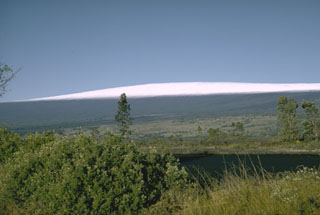Report on Mauna Loa (United States) — April 1984
Scientific Event Alert Network Bulletin, vol. 9, no. 4 (April 1984)
Managing Editor: Lindsay McClelland.
Mauna Loa (United States) Major NE Rift Zone eruption ends; total eruption volume
Please cite this report as:
Global Volcanism Program, 1984. Report on Mauna Loa (United States) (McClelland, L., ed.). Scientific Event Alert Network Bulletin, 9:4. Smithsonian Institution. https://doi.org/10.5479/si.GVP.SEAN198404-332020
Mauna Loa
United States
19.475°N, 155.608°W; summit elev. 4170 m
All times are local (unless otherwise noted)
"The NE Rift Zone eruption, which began on 25 March, ended early on the morning of 15 April. Lava output and fountain vigor steadily decreased during the last week of the eruption. As flow channels became blocked (by sluggish aa and channel collapse breccias) progressively farther upslope, flows terminated higher on Mauna Loa's NE flank. Many short overflows of viscous aa, up to 15 m thick, moved less than a few hundred meters from these points of channel blockage. By 10 April, no lava flowed below 2,400 m. The total area covered by new lavas increased very little after 5 April, as multiple flows mostly piled on top of older flows. Total volume for this eruption was estimated at 180-250 x 106 m3."
Geological Summary. Massive Mauna Loa is a basaltic shield volcano that rises almost 9 km from the ocean floor to form the world's largest Holocene volcano. Flank eruptions typically occur from the lengthy NE and SW rift zones, and from the Moku'aweoweo summit is caldera, which is within an older and larger 6 x 8 km caldera. Two of the youngest large debris avalanches documented in Hawaii traveled nearly 100 km from Mauna Loa; the second of the Alika avalanches was emplaced about 105,000 years ago (Moore et al., 1989). Almost 90% of the surface of the volcano is covered by lavas less than 4,000 years old (Lockwood and Lipman, 1987). Beginning about 1,500 years ago, a series of voluminous overflows from a summit lava lake covered about 25% of the volcano's surface. Over the last 750 years, from shortly after the formation of Moku'aweoweo caldera until the present, an additional 25% of the volcano has been covered with lava flows, mainly from summit and NW rift zone vents.
Information Contacts: J. Lockwood and T. Wright, HVO, Hawaii.

